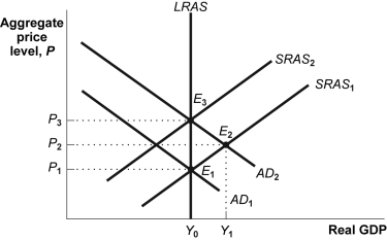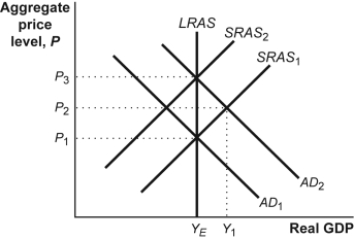A) SRAS; left
B) SRAS; right
C) AD; left
D) AD; right
Correct Answer

verified
Correct Answer
verified
Multiple Choice
Use the following to answer questions :
Figure: AD-AS  -(Figure: AD-AS) Look at the figure AD-AS. Suppose the economy starts at E1 and moves to E2, where AD2 intersects SRAS1. Finally the economy moves to E3. The classical model of price level assumes that the economy moves from _____; thus, inflation _____ and real GDP _____.
-(Figure: AD-AS) Look at the figure AD-AS. Suppose the economy starts at E1 and moves to E2, where AD2 intersects SRAS1. Finally the economy moves to E3. The classical model of price level assumes that the economy moves from _____; thus, inflation _____ and real GDP _____.
A) E1 to E3, ignoring E2; increases; remains the same
B) E2 to E3, ignoring E1; remains the same; increases
C) E2 to E3; decreases; remains the same
D) E1 to E2, ignoring E3; remains the same; remains the same
Correct Answer

verified
Correct Answer
verified
Multiple Choice
The classical model of the price level is most likely to be a good approximation of reality during periods of:
A) recession.
B) high unemployment.
C) low inflation.
D) high inflation.
Correct Answer

verified
Correct Answer
verified
True/False
To balance its budget, the government of Zimbabwe borrowed large amounts of money in world markets.
Correct Answer

verified
False
Correct Answer
verified
True/False
An inflation rate of 5% will increase the purchasing power of $1 to $1.10.
Correct Answer

verified
Correct Answer
verified
Multiple Choice
Expectations of a higher inflation rate shift the short-run aggregate supply curve to the _____, changing the trade-off between inflation and unemployment. As a result, the short-run Phillips curve shifts _____.
A) left; down
B) right; up
C) left; up
D) right; down
Correct Answer

verified
Correct Answer
verified
Multiple Choice
As people get used to inflation:
A) the short-run aggregate demand curve adjusts more rapidly.
B) wages adjust faster, and the short-run aggregate supply shifts quickly to the right.
C) wages adjust faster, and the short-run aggregate supply shifts quickly to the left.
D) the long-run aggregate demand adjusts more slowly.
Correct Answer

verified
C
Correct Answer
verified
Multiple Choice
Use the following to answer question :
Figure: AD-AS Model  -(Figure: AD-AS Model) Look at the figure AD-AS Model. Suppose the economy is at YE with a price level of P1. Which of the following would represent the new long-run equilibrium position if the aggregate demand curve shifted to the right from AD1 to AD2 as a result of an increase in the money supply?
-(Figure: AD-AS Model) Look at the figure AD-AS Model. Suppose the economy is at YE with a price level of P1. Which of the following would represent the new long-run equilibrium position if the aggregate demand curve shifted to the right from AD1 to AD2 as a result of an increase in the money supply?
A) YE and P2
B) YE and P1
C) Y1 and P2
D) YE and P3
Correct Answer

verified
Correct Answer
verified
Multiple Choice
During an inflationary gap:
A) the unemployment rate is less than the natural rate of unemployment.
B) actual output is less than potential output.
C) the unemployment rate is equal to the natural rate of unemployment.
D) wages and prices must fall to restore the economy to its potential output.
Correct Answer

verified
Correct Answer
verified
True/False
It is impossible for the U.S. government to raise revenue by printing more money because the Federal Reserve, not the Treasury, issues most of the U.S. money supply.
Correct Answer

verified
False
Correct Answer
verified
Multiple Choice
Reduction of inflation that is embedded in expectations is called:
A) disinflation.
B) deflation.
C) hyperinflation.
D) the natural rate of inflation.
Correct Answer

verified
Correct Answer
verified
Multiple Choice
The measure that the Fed regards as the best guide to underlying inflation is the:
A) consumer price index.
B) wholesale price index.
C) core inflation rate.
D) federal funds rate.
Correct Answer

verified
Correct Answer
verified
Multiple Choice
When a central bank prints money to pay government debts, causing rising prices that erode the purchasing power of money held by the public, it is called a(n) _____ tax.
A) payroll
B) inflation
C) currency
D) budget
Correct Answer

verified
Correct Answer
verified
Multiple Choice
Inability to use monetary policy because the nominal rate of interest cannot fall below zero is called:
A) liquidity preference.
B) money neutrality.
C) the liquidity trap.
D) money illusion.
Correct Answer

verified
Correct Answer
verified
Multiple Choice
The inflation tax refers to:
A) moving into higher tax brackets.
B) the reduction in the real value of money when inflation falls.
C) the reduction in the real value of money when inflation rises.
D) the tax imposed on inflation by the government.
Correct Answer

verified
Correct Answer
verified
Multiple Choice
An inflation tax is:
A) the reduction in purchasing power due to inflation.
B) a tax on businesses for raising prices.
C) a tax on people with inflated incomes.
D) an excise tax on new automobile tires.
Correct Answer

verified
Correct Answer
verified
Multiple Choice
The short-run Phillips curve represents the relationship between the unemployment rate and the rate of change in:
A) the interest rate.
B) output.
C) wages only.
D) the aggregate price level.
Correct Answer

verified
Correct Answer
verified
Multiple Choice
The long-run Phillips curve shows the relationship between:
A) potential aggregate output and the natural rate of unemployment at a given rate of expected inflation.
B) expected inflation and actual inflation after the expectation becomes embedded in people's minds.
C) the aggregate output and the aggregate price level at a given rate of expected inflation.
D) unemployment and inflation after expectations of inflation have had time to adjust to experience.
Correct Answer

verified
Correct Answer
verified
Multiple Choice
If the money held by the public is $3 billion and inflation is 6%, the inflation tax is:
A) $3.18 billion.
B) $50 billion.
C) $180 million.
D) $1.8 billion.
Correct Answer

verified
Correct Answer
verified
Multiple Choice
The difference between real GDP and potential GDP is known as the:
A) price gap.
B) unemployment gap.
C) output gap.
D) budget deficit.
Correct Answer

verified
Correct Answer
verified
Showing 1 - 20 of 240
Related Exams